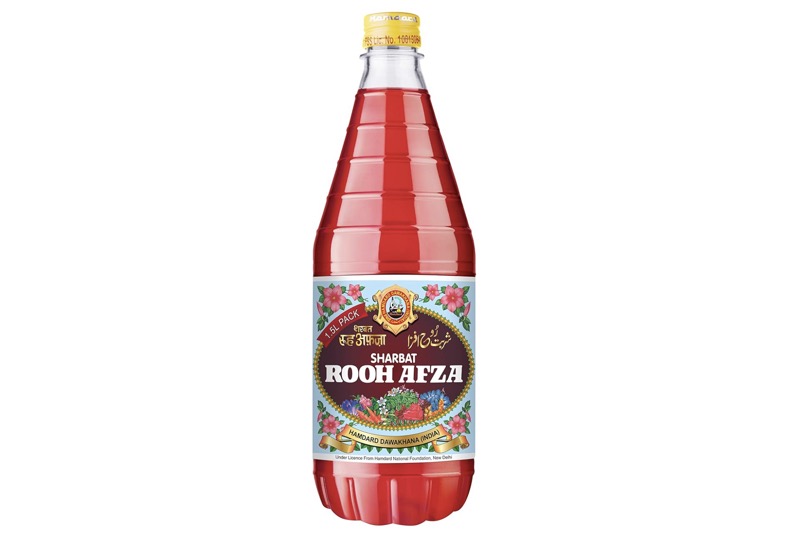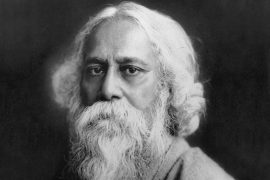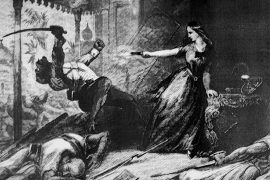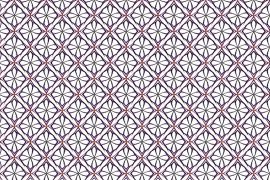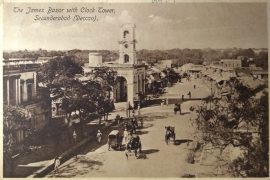Sipping on the juicy concoction of roses, fruits, and other flowers on a summer afternoon is royal bliss. The Mughal King Babur was so fond of his sherbet that he sent for ice in Afghanistan. A cartload of ice wrapped in wool would reach Delhi to produce only a few kilos.
Such was the craze of sherbet, which was served before meals to cool the royals down in the Indian summers. Thanks to them, to this date, they have remained the summer favourites of the entire subcontinent.
In modern day, Rooh Afza, the yummy sherbet, is particularly popular among the ‘Desi households’ worldwide. It represents our culture, quenches thirst, beats the heat, and leaves a refreshing flavour of roses behind.
Rooh Afza has a campaign called ‘Zindagi Mubarak,’ which has become a part of many important celebrations in South Asia. It is served at iftar during the holy month of Ramazan, and is also sold along with street side faloodas.
The Gulf News traced the history of this ruby red, thick sherbet syrup. It was formulated by the founder of Hamdard Labs, Hakim Hafiz Abdul Majeed, a Unani medical practitioner, circa 1907, in Old Delhi.
Majeed intended to create a herbal mix that would keep the people of Delhi cool during summers. With the guidance of Unani medicine, Majeed selected specific herbs to counter heat strokes and prevent water loss. The name Rooh Afza translates to ‘soothing the soul.’
While most practitioners guard the formula of their drugs, Majeed wanted Rooh Afza to be a widely available. He also wanted it to be an inexpensive product so it could benefit every person affected by the Indian heat.
An artist named Miza Noor Ahmad prepared colourful labels for the medicine. They were specifically printed at the Bolton Press run by the Parsees of Bombay. Such colourful prints would not have been possible but for the press available in Delhi. The medication became such a hit that Majeed decided to turn it into a drink.
“When they actually made Rooh Afza for the first time, the flavour and the smell were so enticing that a crowd began to gather around asking, ‘Ho kya raha hai?’ (what is happening?). The whole batch got sold off within an hour,” said Abdul Majeed, grandson of the founder.
Hakim Hafiz passed away in 1922, leaving Rooh Afza behind as a legacy for his two sons to carry. Abdul Hameed and Mohammed Said ran the company hand in hand until 1947 when the partition of India divided their family and the Rooh Afza.
The older brother, Hameed, and his two sons remained in India. Most of the family, along with the younger brother, Said, left for Pakistan. Said established a branch of Hamdard Laboratories in Karachi and later opened one in East Pakistan (now Bangladesh).
“My father migrated to Pakistan on January 9, 1948. The challenges of a fledgling country and a lack of means posed difficulties … he laid the foundation of Hamdard Pakistan in two rented rooms in Karachi’s old area of Arambagh, with Rs 12 (Dh0.42) worth of rented furniture,” said Sadia Rashid, Said’s daughter, the chairperson of Hamdard Laboratories in Pakistan.
In 1971, a local businessman, Dr. Hakim Mohammed Yousuf Harun Bhuiyan, took over Hamdard laboratories in East Pakistan after the partition. The three companies are registered as Waqf, a charitable trust, but they all run independently. They contribute part of their profits to educating and providing medical assistance to the ill and the underprivileged.
Indian and Pakistani Rooh Afza taste similar but are slightly differ in their ingredients. The Indian drink consists of 16 cooling herb extracts and has preserved the original recipe from Majeed’s time, using just a couple of different ingredients.
However, not all ingredients were available when Said travelled to Pakistan, so the recipe needed to be changed a bit.
Internationally, the two branches have divided the turf, and both have become popular drinks, especially amongst the South Asian population living abroad. Indian Rooh Afza is popular in the U.S. and Australia, while the Pakistani counterpart supplies the U.K. and the Middle East.
In the early days, the drink came in wine bottles, sealed with a cork. The current packaging replaced the old one in the 1960s, and the rising cost of glass bottles makes using food-grade plastic bottles convenient.
The new labels for the packaging used in India still use the same design with flowers, fruits, and herbs created by Noor Ahmad. The label highlights ‘Sharbat Rooh Afza’ in Hindi, Urdu, and English. The ones in Pakistan have more floral designs and feature the name only in Urdu and English.
The history of the India-Pakistan partition has deeply affected the history of Rooh Afza. However, its growth as South Asia’s symbolic drink has, in essence, united India, Pakistan, and Bangladesh despite their differences.
A shortage of Rooh Afza in the Indian market caused panic in 2019. Usama Qureshi, the head of Hamdard Labs in Pakistan, offered to ship Rooh Afza as a diplomatic gesture.
Rooh Afza evokes nostalgia for many South Indians. Many of us drink it now to remember our childhood. While Coca Cola and other carbonated drinks may have taken over the global market, Rooh Afza was and will always remain a symbol of South Asia’s shared culture and history.
-30-
Copyright©Madras Courier, All Rights Reserved. You may share using our article tools. Please don't cut articles from madrascourier.com and redistribute by email, post to the web, mobile phone or social media.Please send in your feed back and comments to [email protected]

